doug elkins choreography, etc. performs in Montclair State University’s Peak Performances series.
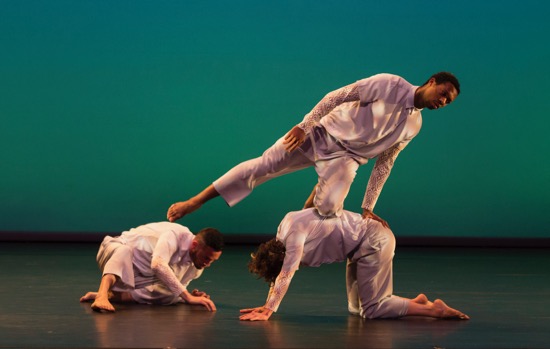
L to R: Elias Rosa, Kyle Marshall, and Donnell Oakley in Doug Elkins’ O, round desire. Photo: Marina Levitskaya
All that I’ve seen on the campus of Montclair State University until now is what I happen on while walking between the Alexander Kasser Theater and the Au Bon Pain. I have also, on a warm evening, sat in the miniature stone equivalent of a Greek theater where I-don’t-know-what takes place and watched the passersby.
Last week, Doug Elkins provided a virtual tour of the campus. He is the third and last choreographer to participate in Montclair State’s Dance for Film on Location initiative— conceived by Jed Wheeler, the executive director of the University’s Peak Performances and funded in part by the Andrew W. Mellon Foundation. (The audience for performances by Elkins’ company, doug elkins choreography, etc., could also visit a room in the theater building and see films centered on the two previous choreographers funded by the initiative: Heidi Latsky and Nora Chipaumire).
The film’s title, A Hundred Indecisions (conceived and directed by Elkins, with Benjamin Seth Wolf as Director of Photography and Tony Pemberton as Editor), may refer to the day-to-day process of making it, as well as to T.S. Eliot’s poem “The Love Song of J. Alfred Prufrock, in which the hero with thinning hair discourses to his unnamed love how there will still be “Time for you and time for me,/And time yet for a hundred indecisions,/ And for a hundred visions and revisions. . . .” (Sound like a choreographer talking?)
Elkins entered dance b-boying and never left those impulses and skills behind—just toted them into postmodern dance, with its affinity for referencing other works and styles. I’m thinking especially of his Where Was Yvonne Rainer When I Had Saturday Night Fever? (1991), Scott, Queen of Marys (1994), Fraulein Maria (2006), and Mo(or)town/Redux (1990, revised 2012 ). In A Hundred Decisions, Ephrat Asherie (known for breaking, hip hop and house), Javier “Ninja” Madrid (a voguing expert), and Carlos Cordova (skilled in house) join Parisa Khobdeh of the Paul Taylor Dance Company, Deborah Lohse, Charemaine Seet, and Elkins’ company members Carolyn Cryer, Cori Marquis, Kyle Marshall, and Donnell Oakley.
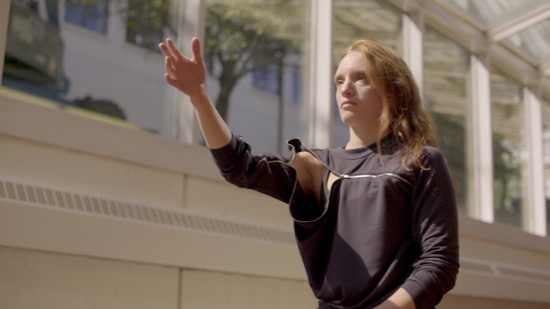
Carolyn Cryer in A Hundred Indecisions. Still image from film. Benjamin Seth Wolf, Director of Photography
Given extra fuel by Justin Levine and Matt Stine’s score, A Hundred Indecisions whisks us into and out of the university’s spaces, Here’s Seet, loose and springy, all by herself in a flagstone hallway. Here’s Oakley spraddling two not-so-high walls. Here’s Khobdeh on the floor of a narrow corridor, pushing herself between one of its walls and the other. Here’s Madrid on his back, propelling himself smoothly across an expanse of floor. Here’s Marshall against a wooden wall. The camera cuts back and forth between these and other dancing images. Sometimes students are seen; often their voices and footsteps are heard as they pass by. We see the dancers briefly from above; we see them in the Alexander Kasser Theater’s windowed lobby and layered on the levels above it. I enjoyed the virtual trip, even as I became somewhat dizzy from the increasingly rapid cuts.
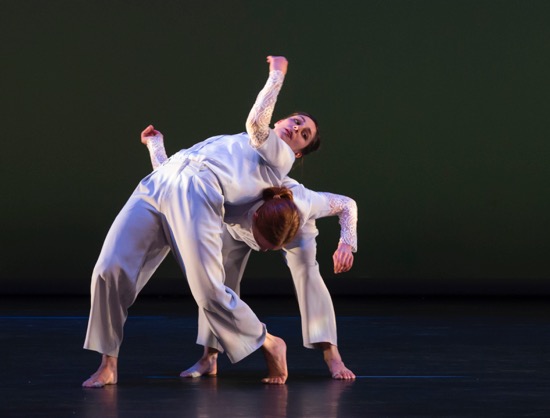
Cori Marquis leans back over Carolyn Cryer in Doug Elkins’ O, round desire. Photo: Marina Levitskaya
O, round desire, a world premiere, was inspired by Gabriel Garcia Marquez’s Love in the Time of Cholera, with its faithful lovers and its polyamorous ones. Stine is credited with Music Production, but we’re on our own identifying early vocal music, a plaintive song from the French Baroque, “Il Mio Tesoro” from Mozart’s Don Giovanni, children’s voices, Philip Glass’s thrumming repetitions, and perhaps more.
Elkins, collaborating with the dancers, has created a lush stew of movement, in which Cryer, Marquis, Marshall, Oakley, and Elias Rosa slide and spring and flow and tumble in and out of relationships. It made me think of an idyllic 1970s commune in which even hoeing and digging could acquire a certain glow. Elkins’ background in breaking means that the excellent dancers are often upended, balanced on one hand, somersaulting, using another person as springboard, inching along supine. Wearing loose-fitting white clothing with lacy sleeves by Oana Botez and handsomely lit by Amanda K. Ringger, they avoid disputation and don’t seek for permanence, even as they mastermind intricate connections with one another—dipping under, swinging over, darting past. Something you don’t see in much choreography: a performer may occasionally touch, even grasp, another’s head or run his/her hands down another’s chest. One of the most memorable passages is a duet for Marquis and Cryer—wonderful dancers both. So quietly tumultuous is the dancing that the rare pauses become moments to value, to cherish.
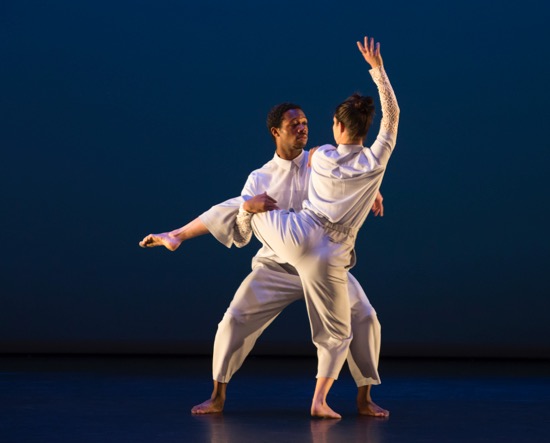
Kyle Marshall Kyle Marshall and Cori Marquis in O, round desire. Photo by Marina Levitskaya
Partway through the piece, these dancers are joined by six students from Montclair State’s Department of Theater and Dance and by three from the Mason Gross School of the Arts at Rutgers University, where Elkins teaches. The choreography keeps them less mobile in space than their more experienced, flying-around colleagues, and Elkins has created effective contrapuntal passages for them as well as bringing various ones of them into the foreground.
The ending is curious. The music just fades away, and that’s that.
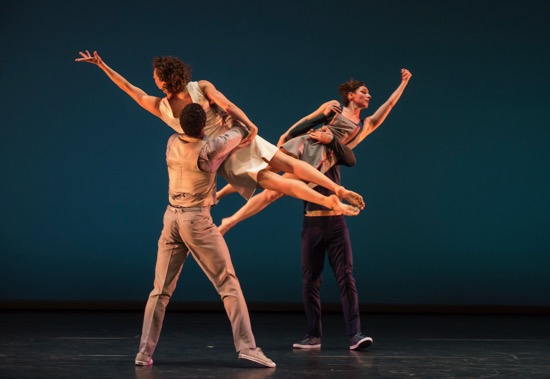
L to R: Kyle Marshall, Donnell Oakley, Cori Marquis, and Elias Rosa in Doug Elkins’ Mo(or)town/Redux. Photo by Marina Levitskaya
O, round desire marks the debut of company dancer Elias Rosa, and he is one of the four dancers in the revival of Elkins’ Mo(or)town/Redux. Take away the parenthetical “or,” and you have Motown; take away the parenthesis and you have Moortown. So Elkins is conveying the both essential structure of Shakespeare’s Othello and that of José Limón’s masterpiece, The Moor’s Pavane, to a Motown climate. As in the 1949 piece, the cast is narrowed down to four. Although Shakespeare’s names are not used in the program, I’ll use them here for clarity: Othello (Marshall); his wife Desdemona (Oakley); Iago (Rosa), a soldier who served under Othello; and Emilia, his wife and Desdemona’s attendant (Marquis).
We don’t need to learn plot details (Cassio being promoted over Iago, for instance, and Iago’s resulting anger and jealousy). As in Limón’s work, the four principal characters keep coming together in a circular dance, and that balance is destroyed by a handkerchief. It’s enough to understand that Oakley accidentally drops the piece of fine white cloth that Marshall gave her, that Marquis picks it up and gives it to Rosa as ordered, and that Rosa flourishes it, whispering things to Marshall about the innocent Oakley, after which there’s no turning back.
Some of the musical selections (credited to Levine and Stine) were chosen for their words. Marshall, dapper in a white suit (costumes by Naoko Nagata), wields a mic on a stand while James Brown (I think) sings “This is a man’s world. But it wouldn’t be nothing, nothing without a woman or a girl.” And when he’s preparing to kill his wife, we hear Marvin Gaye: “You wonder how I knew before. I heard it through the grapevine.”
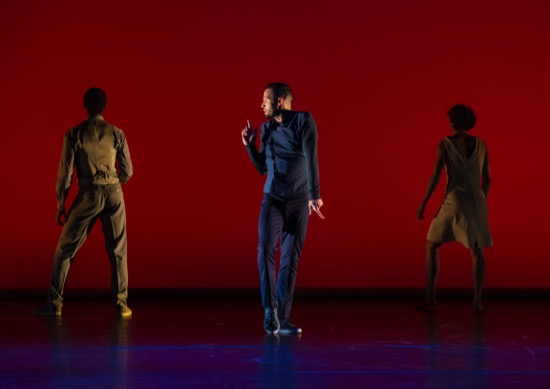
L to R: Kyle Marshall, Elias Rosa, and Donnell Oakley in Doug Elkins’ Mo(or)town/Redux. Photo: Marina Levitskaya
Elkins boldly and movingly adopts and adapts Limón’s devices. A triumphant solo for Marquis, sure her mate will be happy to get the handkerchief she’s playing with. A devious one for Rosa, plotting in a military-style jacket that keeps him taut and narrow, despite the hints of hip-hop, Rosa whispering accusations in Marshall’s ear, riding him as he tries to get away. Oakley’s growing confusion and fear. Marshall’s fury, grief, and, in the end, numbness (his performance is remarkable). We don’t see the killing; he has his back to us. But we know when it happens. The piece is heartrending, but in a different way from Limón’s, with its Renaissance costumes and music by Henry Purcell. It hints at power plays, gang warfare, revenge, and the deaths of innocents who get in the way. Sound familiar?

“quietly tumultuous” Yum!